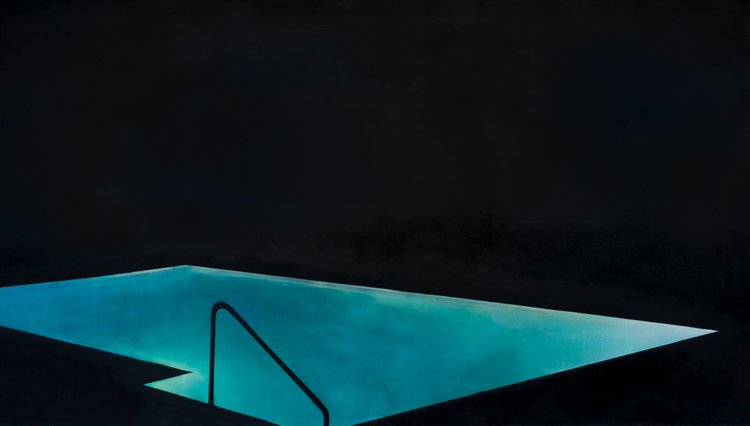JUNE 2014
In Night Pools, his striking new series of large paintings, Robert Bingaman presents isolated, glowing swimming pools hovering in fields of blackness – familiar backyard subjects transformed into enigmatic and richly evocative images. Inspired by wistfully recalled childhood memories – as a child growing up in Wichita Bingaman longed for a pool in his own backyard – and by the artist’s ongoing reverence for the middle-American landscape, the pictures are also impelled by an ambition to forge formally distinguished and deeply meaningful art from such everyday sources.
While they are animated by his personal memories and experiences of backyard swimming pools glimpsed in passing or enjoyed as a guest, each of Bingaman’s paintings actually originates with a photograph. Bingham finds the photograph online or scans it from a commercial publication such as Sunset Books’ Swimming Pools and Spas, then manipulates it in Photoshop to blanch out the surrounding architecture and landscape and to visually isolate the pool. A second Photoshop study predicts the painting by surrounding the pool with blackness. This is followed by a drawing on the same scale which reduces the swimming pool to an outline, and which Bingaman projects onto a white gesso-covered canvas in order to trace the shape of the swimming pool onto its surface. To start the painting he masks out the pool and covers the rest of the canvas with acrylic pigments in a warm hue such as red or orange, applied with sweeping strokes of a wide house painter’s brush. Bingaman then uncovers the swimming pool, masks its edges, and fills its interior with layers of thin, loosely applied oil paint, predominantly in a hue complementary to the acrylic color laid down around it. Next he applies blacks over the expanses of canvas surrounding the pool, again using house painter’s brushes and loose swaths of oil paint. He uses smaller brushes to adjust the borders where the black bounds the pool, and to define details such as a diving board, skimmer, or stair rail. Finally, he sands down the blacks and applies an oil glaze over the whole surface of the painting to seal it.
Bingaman’s starkly outlined pools, filled with luminous blue or green, range in shape from a simple quadrilateral to more complex configurations, and are viewed obliquely so that they seem to lean back in space along diagonal lines of perspective. At the same time, their unshaded interiors, lacking indications of walls or floors, can cause them to be read as flat, evoking comparisons to the classic hard-edge paintings of Ellsworth Kelly, which present silhouetted shapes in a single color against a field of another color. Unlike Kelly’s clean, smoothly brushed surfaces, however, Bingaman’s pictures reveal ample evidence of his active process of laying down his pigments in layers. Delicate vertical streaks of turpentine-thinned oil paint lace the interiors of his pools, while patchy textures and traces of gestural brushstrokes fill the surrounding areas of black. This evidence of the artist’s hand tempers the overall geometric compositional structure of the paintings and invests them with an expressive quality that Bingaman considers romantic.
The distinctive character of Bingaman’s pictures is further clarified by comparing them to David Hockney’s famous swimming pool paintings of the mid-1960s. Celebrations of the hedonistic lifestyle enjoyed by privileged Southern Californians, Hockney’s accessible, sun-filled compositions offer expanses of blue water in the foreground that invite us to imagine diving in. By contrast, Bingaman shrouds his pools in blackness to deprive them of geographical specificity (though he insists they are American) and he separates them from the viewer by positioning them as if observed from an elevated vantage point and an unbreachable distance. Furthermore, even if we could approach them we can hardly envision jumping into Bingaman’s pools, which seem filled not with actual water but with illumination that registers as a kind of numinous glow. Indeed, Bingaman is highly conscious of the spiritual meanings that many world religions attach to water, and he understands any large volume of this element – be it an ocean, a reflecting pool, or a swimming pool – as a locus of mystery and power. And ultimately it is the symbolic potential of Bingaman’s pictures, combined with their formal authority, which gives them their remarkable resonance. These visionary Night Pools transcend the quotidian reality of illumined backyard pools to evoke not only the elemental contest between light and darkness, but even more, the aching appeal of everything that attracts us but which we can never truly possess.
- David Cateforis

